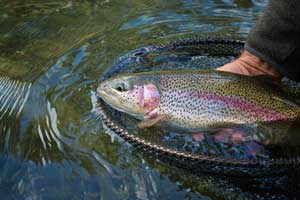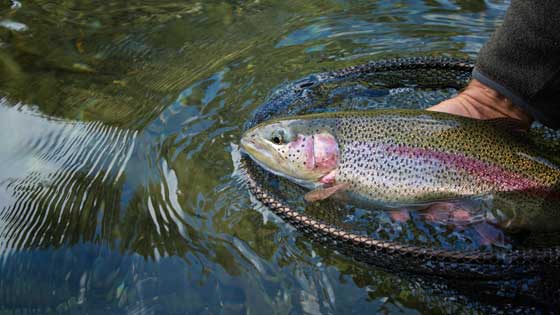Rainbow Trout An Introduction

The Rainbow Trout and Steelhead Trout are the same species.
Fish that are sea-run are called Steelhead Trout and those that are landlocked or remain in freshwater all year around are called Rainbow Trout.
We’ll use both names in the pages ahead even those that are named Rainbow Trout. Rainbow Trout are one of the most popular species of freshwater fish caught in North America. Other well known freshwater fish species include the Altantic Salmon, Sockeye Salmon, Largemouth Bass, Smallmouth Bass, Lake Trout and the Cutthroat Trout.
When is a trout not a trout?
Not all fish that are named trout are true trout.
While the Rainbow Trout was originally classified as a trout, they’ve since been moved to the Pacific Salmon family.
Other fish species like the Bull Trout and Lake Trout have been given the name with little regard to the scientific classification method.
In the United States naming, (or branding) is considered very important. Various fish species are given names not because of their true identity but because the name will make them more popular. While this is not always the case, there’s many examples of popular fish being named this way.
- Interestingly the Peacock Bass is not even close to being a bass at all and was named a bass so it would become popular with Florida Anglers.
- The Lake Trout and Bull trout are actually members of the Charr family of which there are 5 main species.
This creates a problem for us here at Bass Fishing Gurus as we’re not sure which category to best put them in. For charr, it’s very clear which fish are charr and all the literature agrees so only charr and their subspecies are placed in that category. For salmon, only salmon species are placed in that category. But for trout the decision is much more difficult and inconsistent as there’s so much confusion by anglers from literature they’ve read.
DNA shows Rainbow Trout are Pacific Salmon
The natural range of the rainbow trout (Salmo gairdneri) is from northern Mexico to the Aleutian Islands. The two distinct strains of rainbow trout are the steelhead and shasta strains. The former has a migratory instinct to swim to the sea, while the shasta strain is non migratory.
Rainbow Trout was named by Johann Julius Walbaum in 1792. The Rainbow Trout was further classified in 1836 by Richardson, Salmo gairdneri. Then again in 1855, W. P. Gibbons classified the Rainbow Trout as Salmo iridia, which was incorrect and later corrected to read Salmo irideus. These names failed to gain acceptance as there were issues with the naming convention and they failed to gain any traction.
Once DNA became available, research showed that the Rainbow Trout is closely related to the Pacific salmon (Onchorhynchus species) much more than the brown trout (Salmo trutta) or even the Atlantic salmon (Salmo salar).
The Rainbow Trout is now accepted as being a member of the Pacific Salmon species – as odd as it may seem to any long time anglers.
Conservation
Inland stocking programs have allowed both strains to mix, creating inland rainbows with the dominant migratory instinct. As a result, many rainbows initially stocked inland are eventually found in the sea.
Rainbow Trout are not under any major threat to their survival. They’re not placed on the threatened species list nor are they expected to be placed there anytime soon due to their large distribution and significant numbers.
How a species gets classified as a threatened species
The United States has classified a threatened species differently from the scientific community. If a population of fish are limited to a single river distribution and don’t interact with other fish from other rivers or change their spawning grounds, they’re considered a separate species for preservation.
They’re termed ‘Evolutionary Significant Units’ and can be placed on the endangered or threatened list. The upper Columbia river is one such ESU where the Rainbow Trout are considered threatened due to human activities.
Keeping the population healthy is still a responsibility of the angling community. Unless you’re planning on eating the fish you catch, consider the catch and release techniques presented on our site. Avoid excessive tiring of the Rainbow Trout and cradle them before letting them go to greatly increase their survival rate.
Top Sport Fish
The Rainbow trout is a top sport fish in the United States and Canada. They can be caught either with baitcasters, by trolling and by using fly fishing gear. If you’ve never tried fly fishing, this is one fish that gives you good reason to learn fly fishing.
‘All Tackle’ Rainbow Trout record
The largest ‘all tackle’ Rainbow Trout ever caught was on Saskatchewan’s Lake Diefenbaker by Sean Konrad on September 5, 2009. The Rainbow weighed a massive 48 pounds /21.8 kilograms.
Tackle used to catch this prize included
- A 9ft 6in Shimano Clarus spinning rod with an ABU Garcia Cardinal reel spooled with 14lb test green power pro.
- A 3ft leader of 14 lb test trilene max monofilament with a rapala 5 1/4 in X-rap jointed lure.
(By the way, Lake Diefenbaker was named after a former Canadian head of state.)
If you’re wanting to find out more about the Shimano Clarus spinning rod and ABU Garcia Cardinal reel



